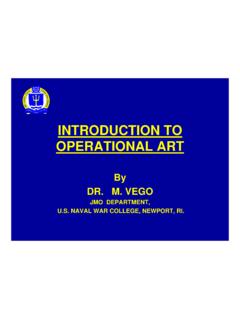Transcription of NAVAL WAR COLLEGE NEWPORT PAPERS
1 36 Defeating the U-boat Jan S. BreemerNAVAL WAR COLLEGE NEWPORT PAPERSI nventing Antisubmarine Warfare36 NAVAL WAR COLLEGE NEWPORT PAPERSTHEUNITEDSTATESNAVALWARCOLLEGEVIRA IBUS MRI VICTORIATHEUNITEDSTATESNAVALWARCOLLEGEVI RAIBUS MRI VICTORIAR eport Documentation PageForm ApprovedOMB No. 0704-0188 Public reporting burden for the collection of information is estimated to average 1 hour per response, including the time for reviewing instructions, searching existing data sources, gathering andmaintaining the data needed, and completing and reviewing the collection of information. Send comments regarding this burden estimate or any other aspect of this collection of information,including suggestions for reducing this burden, to Washington Headquarters Services, Directorate for Information Operations and Reports, 1215 Jefferson Davis Highway, Suite 1204, ArlingtonVA 22202-4302.
2 Respondents should be aware that notwithstanding any other provision of law, no person shall be subject to a penalty for failing to comply with a collection of information if itdoes not display a currently valid OMB control number. 1. REPORT DATE AUG 2010 2. REPORT TYPE 3. DATES COVERED 00-00-2010 to 00-00-2010 4. TITLE AND SUBTITLE Defeating the U-boat. Inventing Antisubmarine Warfare 5a. CONTRACT NUMBER 5b. GRANT NUMBER 5c. PROGRAM ELEMENT NUMBER 6. AUTHOR(S) 5d. PROJECT NUMBER 5e. TASK NUMBER 5f. WORK UNIT NUMBER 7. PERFORMING ORGANIZATION NAME(S) AND ADDRESS(ES) NAVAL War COLLEGE ,Center for NAVAL Warfare Studies, NEWPORT ,RI,02841 8. PERFORMING ORGANIZATIONREPORT NUMBER 9. SPONSORING/MONITORING AGENCY NAME(S) AND ADDRESS(ES) 10. SPONSOR/MONITOR S ACRONYM(S) 11. SPONSOR/MONITOR S REPORT NUMBER(S) 12.
3 DISTRIBUTION/AVAILABILITY STATEMENT Approved for public release; distribution unlimited 13. SUPPLEMENTARY NOTES 14. ABSTRACT 15. SUBJECT TERMS 16. SECURITY CLASSIFICATION OF: 17. LIMITATION OF ABSTRACT Same asReport (SAR) 18. NUMBEROF PAGES 86 19a. NAME OFRESPONSIBLE PERSON a. REPORT unclassified b. ABSTRACT unclassified c. THIS PAGE unclassified Standard Form 298 (Rev. 8-98) Prescribed by ANSI Std Z39-18 GOVERNMENTOFFICIAL EDITION NOTICEUse of ISBN PrefixThis is the Official Government edition of thispublication and is herein identified to certify itsauthenticity. ISBN 978-1-884733-77-2 is for this Printing Office Official Edition only. TheSuperintendent of Documents of the Govern-ment Printing Office requests that any reprinted edi-tion clearly be labeled as a copy of the authentic workwith a new Status and Use of Seals and LogosThe logo of the NAVAL War COLLEGE (NWC), NEWPORT , Rhode Island, authenticatesDefeating the U-boat: Inventing Antisubmarine Warfare,by Jan , as an official publication of the COLLEGE .
4 It isprohibited to use NWC s logo on any republication ofthis book without the express, written permission ofthe Editor, NAVAL War COLLEGE Press, or the editor Sale by the Superintendent of Documents, Government Printing OfficeInternet: Phone: toll free (866) 512-1800; DC area (202) 512-1800 Fax: (202) 512-2104 Mail: Stop IDCC, Washington, DC 20402-00001 ISBN: 978-1-884733-77-2 CoverThis perspective aerial view of NEWPORT ,Rhode Island, drawn and published byGalt & Hoy of New York, circa 1878, isfound in the American Memory OnlineMap Collections: 1500 2003, of theLibrary of Congress Geography and MapDivision, Washington, The mapmay be viewed at :\_WIP\_Newport paper \_NP36\ , August 23, 2010 1:37:46 PMColor profile: DisabledComposite Default screenDefeating the U-boatInventing Antisubmarine WarfareJan S.
5 Breemer 2010 by Jan S. BreemerNAVAL WAR COLLEGE PRESSN ewport, Rhode :\_WIP\_Newport paper \_NP36\ , August 23, 2010 1:37:49 PMColor profile: DisabledComposite Default screenNaval War CollegeNewport, Rhode IslandCenter for NAVAL Warfare StudiesNewport paper Thirty-sixAugust 2010 President, NAVAL War CollegeRear Adm. James P. Wisecup, USNP rovostAmb. Mary Ann PetersDean of NAVAL Warfare StudiesRobert C. RubelNaval War COLLEGE PressDirector:Dr. Carnes LordManaging Editor:Pelham G. BoyerTelephone: : exchange: 841E-mail: : in the United States of AmericaThe NEWPORT PAPERS are extended research projects that theDirector, the Dean of NAVAL Warfare Studies, and thePresident of the NAVAL War COLLEGE consider of particularinterest to policy makers, scholars, and views expressed in the NEWPORT PAPERS are those of theauthors and do not necessarily reflect the opinions of theNaval War COLLEGE or the Department of the concerning the NEWPORT PAPERS may beaddressed to the Director of the NAVAL War COLLEGE request additional copies, back copies, or subscriptionsto the series, please either write the President (Code 32S)
6 , NAVAL War COLLEGE , 686 Cushing Road, NEWPORT , RI02841-1207, or contact the Press staff at the telephone, fax,or e-mail addresses and printing are subject to the Copyright Actof 1976 and applicable treaties of the United States. Thisdocument may be freely reproduced for academic or othernoncommercial use; however, it is requested thatreproductions credit the author and NEWPORT PAPERS seriesand that the Press editorial office be informed. To obtainpermission to reproduce this publication for commercialpurposes, contact the Press editorial 1544-6824 ISBN 978-1-884733-77-2 The author thanks the Smith Richardson Foundation for its support,which helped make writing this story new front :\_WIP\_Newport paper \_NP36\ , September 08, 2010 8:13:59 AMColor profile: DisabledComposite Default screenContentsForeword,by Carnes LordvIntroduction: We Are Losing the War 1 CHAPTER ONE The Submarine Boat Does Not andCannot RevolutionizeNaval Warfare 5 CHAPTER TWOC utting the Thin Thread25 CHAPTER THREE The Old Theories Have Been Tried andFound Wanting 47 CHAPTER FOUR We Run a Great Risk of Losingthe War 57 Conclusion69 Abbreviations81 About the Author83 The NEWPORT :\_WIP\_Newport paper \_NP36\ , August 23, 2010 1:37:49 PMColor profile.
7 DisabledComposite Default screenForewordTheemergenceofoperationall yeffectivesubmarinesinthedecadeorsoprece dingtheoutbreak of World War I revolutionized NAVAL warfare. The pace of change in navaltechnologies generally in the late nineteenth century was unprecedented, but the sub-marine represented a true revolution in the nature of war at sea, comparable only tothe emergence of NAVAL aviation in the period following the First World War or ofballistic missiles and the atomic bomb following the Second. It is therefore not alto-gether surprising that the full promise and threat of this novel weapon were not imme-diately apparent to observers at the time. Even after submarines had proved theireffectiveness in the early months of the war, navies were slow to react to the new strate-gic and operational environment created by them.
8 The Royal Navy in particular failedto foresee the vulnerability of British maritime commerce to the German U-boat,especially after the Germans determined on a campaign of unrestricted submarinewarfare attack without warning on neutral as well as enemy merchant shipping in the U-boat: Inventing Antisubmarine Warfare, NEWPORT paper 36, Jan tells the story of the British response to the German submarine threat. Hisaccount of Germany s asymmetric challenge (to use the contemporary term) to Brit-ain s NAVAL mastery holds important lessons for the United States today, the Navyin particular. The Royal Navy s obstinate refusal to consider seriously the option ofconvoying merchant vessels, which turned out to be the key to the solution of the U-boat problem, demonstrates the extent to which professional military cultures canthwart technical and operational innovation even in circumstances of existential historical controversy continues to cloud this issue, Breemer concludes thattheconvoyingoptionwasembracedbytheRo yalNavyonlyunderthepressureofcivil-ian authority.
9 Breemer ends his lively and informative study with some general reflec-tions on military innovation and the requirements for fostering LORDD irector, NAVAL War COLLEGE PressNewport, Rhode :\_WIP\_Newport paper \_NP36\ , August 23, 2010 1:37:50 PMColor profile: DisabledComposite Default screen We Are Losing the War On 10 April 1917, Rear Admiral William Sowden Sims, Navy, sat across from theRoyal Navy s Admiral of the Fleet Sir John Rushworth Jellicoe. Sims and his aide hadarrivedinLondononthatsameday,lessthan twenty-fourhoursaftertheirpassengersteam er had docked in Liverpool. While they were at sea, on 6 April, the AmericanCongress had declared war on Germany and its allies. Anticipating hostilities, the Secretary, Josephus Daniels, had ordered Sims to London to, in Sims s words, getin touch with the British Admiralty, to study the NAVAL situation and learn how wecould best and most quickly cooperate in the NAVAL war.
10 1 Now, sitting across fromhim calm, smiling and imperturbable was the First Sea Lord. With operationalresponsibility for the entire British navy, Jellicoe was well placed to confirm the beliefof Sims and most Americans that the British fleet had the situation well in hand. 2It did not. Sims was shocked to learn that the struggle against the U-boats had been farless successful than was being portrayed in the American and British he realized that the numbers of sinkings of British and neutral merchantmenwere three and four times larger than reported, Sims observed, It looks as thoughthe Germans were winning the war. 3 Jellicoe agreed. New, promising weapons, notablythe depth charge, were being developed, but if the U-boats kept up their current paceof sinkings, they would not be ready in time. That was why it was critical that the immediately send help in the way of destroyers and other small vessels.



















